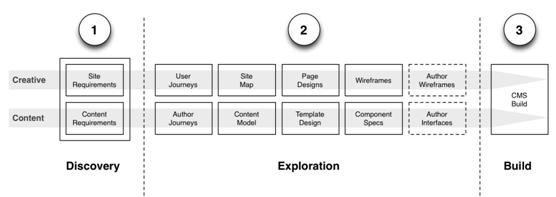- CMS Build Project Paths
- Simple Site for Authors
An on-going challenge for CMS build projects is that they are pre-dominantly design led with the primary focus set on publishing content. With less attention paid to users in content producing roles, editorial needs are rarely catered. The new solution goes live and “The CMS” quickly becomes a dirty word because it has not been deployed to effectively create, understand and manage content. Sound familiar?
Content producers do a lot of things – Create content, Find content, Re-use content, Value content, Review content, Tag content. The CMS also pulls its weight with content: storing, indexing, auto tagging, displaying, recommending, publishing and workflow. This requires us to think really hard about how we intelligently structure content. And that’s where the battle is waged today for both time and effort to do editorial thinking on CMS build projects.
Instead, what typically happens during the early stages of a web content project and leading through into the build is that focus lies almost entirely on the customer-facing aspects of the web-site: the simple publishing challenge. Unless we start turning our focus inwards and shining the light on the difficult editorial challenge, CMS projects will forever be slated as those projects doomed never to deliver on business expectations.
The first post in this series highlighted the issues CMS projects faced following the build path above. Today, we’re going to add another path to the project that gets us thinking more about authors.
The three stages above map onto the way creative agencies tend to engage on content projects. This is no coincidence. A CMS build will always take creative assets as outputs. However, we need to ensure that these outputs make sense as inputs to the build process. And in order to help shape the quality of creative outputs, technologists need to step up and into the creative design process to:
- Explain how creative outputs impact the build.
- Demonstrate the CMS art of the possible/impossible.
- Highlight gaps in the outputs that the project needs to plug.
For a simple site, with authors, we need to work with both paths in parallel: creative and content. Whether it’s a short-lived digital campaign, a long running micro site or the corporate web site itself, we need to consider both paths if the content is going to end up in the CMS. In doing so, intelligent value decisions can be discussed in an open and transparent way, at time when they can be acted upon:
- Should we invest in building tailored authoring interfaces that both simplify and enhance the content creation process, or rely upon the “out of the box” CMS interfaces?
- Do we really need to single-source content for re-use across the business, and do we have the skills and backing to do that?
- Where is the web site going? Does it need to evolve to better support multiple channels, multiple devices, multiple sites, multiple languages, multiple business units, multiple products, multiple authors, multiple blah?
Based upon these decisions, you can get a feel for how much effort needs to be placed into the content stream. It’s funny (not really) how many of these decisions are encountered during the build. It’s scary (really scary) just how many of these decisions are made by developers, unbeknown to the business, in order the get the CMS projects delivered. Why?
Instead, open the box. Look inside what goes on it a CMS build. If you’re on the creative side, re-visit your outputs and see if they are catering for content producers. For CMS folks, are you holding the line and waiting for the right outputs? Why aren’t you rolling up your sleeves and getting involved to help mould them into something you can really work with.
This is where I see content strategy playing a vital role in pulling these two streams of people, process, and products together. The reality is that this is a really hard sell because it requires change on both side, and for the client to buy into it (literally).
It also has a lot to do with the digital maturity of the organisation, and to a certain extent, their content maturity. For media folks, where content is their product, there is no sell. They get it. They know the value of content. So for them it’s more about their ability to execute, which points more to their digital maturity. Where we are dealing largely with marketing content, it’s a much harder sell. But with mobile firmly on the executive boardroom agenda, multi-channel content and all its disruptive challenges, things are starting to change. And with that change, maybe, we can better communicate and take these additional paths during CMS builds projects.


